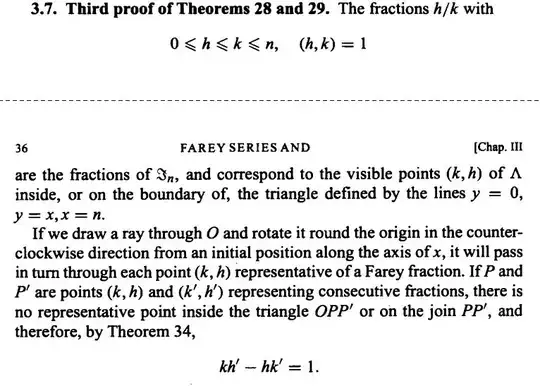After a few discussions regarding lattices, fundamental lattices and some of their properties, the author writes this proof of a theorem regarding Farey series. I don't really see how some of his claims follow. They're not so obvious to me. I get how only visible points inside or on the boundary represent all the fractions of the Farey series, but how does he know that there won't be any representative point inside the triangle OPP' ? Also, what about the case where the two consecutive fractions are $\frac{0}{1}$ and $\frac{1}{n}$ ? We don't have a triangle in that case.
Asked
Active
Viewed 81 times
1
-
Is that why he said "or the joint PP'" ? For the case that P coincides with O? – Brain Stroke Patient Nov 09 '19 at 19:23
-
2The points $(0,0), (1,0), (n,1)$ do form a triangle. That there's no Farey point in the triangle $OPP'$ or on the line segment joining $P$ and $P'$ follows from the "consecutive", since a point in that triangle or on the join would lie between $\frac{h}{k}$ and $\frac{h'}{k'}$. – Daniel Fischer Nov 09 '19 at 19:29
-
Is it because if a fraction $\frac{h''}{k''}$ existed in the triangle OPP' , then the line connecting this fraction would have slope $\frac{h''}{k''}$ which must be less than the slope of OP', $\frac{h'}{k'}$ and greater than the slope of OP, $\frac{h}{k}$ but which would then mean that $\frac{h}{k}$ and $\frac{h'}{k'}$ aren't consecutive? @DanielFischer – Brain Stroke Patient Nov 09 '19 at 20:20
-
Yes, that's it. – Daniel Fischer Nov 09 '19 at 20:21
-
1There's a beautiful proof by Pick's Area Theorem. – Bill Dubuque Nov 09 '19 at 22:58
